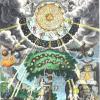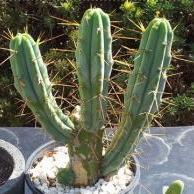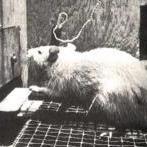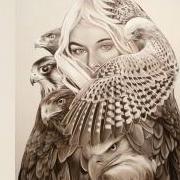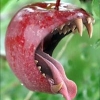Leaderboard
Popular Content
Showing content with the highest reputation on 20/12/15 in all areas
-
3 pointsAny ideas? Blue bruising, length of 2-3cm, cap diameter 1-1.5cm. I bought the fern a few weeks ago and they keep popping up.
-
2 pointsTake a print! There are others here with a much better idea than me, but I agree that it does look kind of subby. Never paid much attention to the ferns in Bunnings - that's going to change now! Edit: spelling
-
2 pointskt, I've thoroughly enjoyed the history and am very much looking forward to comments addressing the "quite recognizable and distict" differences between T. peruvianus and T. macrogonus, differences which you appear to indicate don't necessarily mean they are different species. I can easily gather that the name T. macrogonus might have precedence over the name T. peruvianus, but if these two can be recognized as distict from each other, and therefore be worthy of a difference in name, even if that be at the subspecies or variation level, then what of the plethora of others that may have comparable disimilarities but are clearly in the same species? Are we then to create a plethora of subspecies or variations? ~Michael~
-
1 pointhey you all anybody out there have any info on this plant? from what i can ascertain it was chewed by the locals in the western cape as a thirst quencher and stimulant, but so far can get no first hand info from anyone, did manage to get 4 seed which germinated, and 13 seedlings from under a tree, did taste the mature soft leaves and there is definitely an alkaloid in there, more bitter than catha even on unpruned trees, will post a few pics of the big trees next time we up there.
-
1 pointWas walking through a particular university in West Aus after a 4 hr sleep and 3 hour exam when I got hit by the vibe. I had that this would be perfect for mushrooms idea. I stopped, looked to my right and bam, the first two. The rest were found within 30 meters of each other. It's great at a uni cause you can get all hands and knees, staring at the dirt with an iPhone and you actually look like you might be doing something important. You can look people right back in the eyes and think "maybe I'm a botanist/ mycologist...I'm doing serious work here move along!" You can look all academic and shit, rubbing you chin and looking around with a furious purpose. One person even walked over to see what I was gettin all hands and knees about! Apart from the Gym I know nuthing about these things...anyone??? Got a sweet post to make about extensive myco adventures in Thailand when I have time to sort photos. Was such a great experience it deserves a decent post.
-
1 pointward. I looked upon the ward and gazed the place were special people have a special place. wondering weather I belong in this twisting maze. I see sorro, heartbreak & delusion painted on faces glazed. I take a sip of water from my jug and sip. I ponder the roads these have taken to end up in there little trip. I'd take to them a basket of treats if I knew it would help even just a bit. but these are the those that the maker has seemingly deemed unfit. wert. 12/12/15
-
1 pointFlowers popped last night so pollinating and collecting pollen started in earnest. Knuth Unnamed sexy pachanoi "Anakie" peruvianus
-
1 point
-
1 pointIf you want to live without these things, then why are they still in your life? You could probably achieve a life free of this stuff simply by going to live in a cave in a national park somewhere & eating snakes for the rest of your days. It might be a difficult decision, but it's not a complicated one. The point I was trying to make earlier is that there is usually a trade-off. You have let these things into your life with something that you wanted (or thought you wanted). When you decide you want to live without those arguments with your girlfriend, say, sometimes the only way to achieve that is by breaking up with her. Likewise with the social connections you're talking about - to be free of the bad, you would probably sever your ties with a lot of stuff that you like - a whole lot of physical & social comforts. What I was asking was: which of those trade-offs might be worth it for you? What I am slowly realising is that many of the things I had been taught to like are not things that I want at all, or if I do want them, I don't want them enough to pay the hidden costs associated with them. So why not ditch capitalism like the nagging girlfriend that she is, and join me out in that national park? I'm not sharing my cave though, get yer own.
-
1 pointI have 1.4 kg rivea corymbosa seeds unhulled which i'd like to trade. anyone interested pm me what you would like to trade. i don't know what the postage will cost, so they may not be included - depending on the trade
-
1 pointIt's a Psathyrella of some kind. Olive, all scientific Latin names are oficially written in italics. Actually, in scientific papers and books and such, all Latin words are in italics. Don't think the main reason is to stick out in a block of text, but it definitely helps.
-
1 pointVery nice! I guess it could easily be a slightly odd looking P. subaeruginosa, I tried to find something that would fit better, but no luck. Still, you should preserve a piece of tissue if you one day find someone who would want to look at it under the scope.
-
1 pointThunderhorse is correct, it's Leucocoprinus birnbaumii. Toxic if ingested, but beneficial to plants.
-
1 pointAlso, to clarify one important thing brought up by Michael. Any of these particular Trichs have the capacity to naturalize the right habitat and even a bit beyond it. At what point do those become thought of as natural populations or even native flora? After we are long since dead and gone obviously but it is a question that applies to lots of things. We think of the American bison as an enduring species yet it is known to be a natural hybrid of pleistocene origin that outcompeted its parent species. It is now natural and native and a normal part of life on this continent. Similarly, it seems likely to only require some thousands of years before a number of the Trichocereus species, most especially the pachanot, will very likely be regarded as part of the native flora of the Pacific Coast of what is now California. The earth has been rearranged dramatically by humans and even more so by plate movement, volcanism and glaciation, all of which appear to have played some role in what we are thinking of as the modern face of Cactaceae. I think we would benefit by factoring human involvement into the equation as a natural force capable of increasing or decreasing the distribution of species. If we were to do so it could greatly help quantify our actual level of impact.
-
1 pointI think that is how botanists work even into modern times. Molecular work proceeds on similar grounds. The novel is determined by comparison with the known. As a descriptive system goes it has a internal referential reality that is based on its members. If there is motivation for finding new species, new species can be created simply by increasing the types and degree of differences that are considered significant. Hence the battle between lumpers and splitters. Its not really about science, it is about personal viewpoints and preferences. In a great many ways it is arbitrary which direction one chooses so long as the work is done well and the members being studied can be described and recognized. Obviously as either heads towards their extreme they produce useless systems due to becoming unweildy. Either from too many names, which will by natures lead to the discovery of more, or for sake of not adequately defining their subsets in a way that can be navigated. For instance if we were to collapse all to species of Opuntia, Cactus and Cereus species. One difference between now and older botanical approaches is not just that we have more powerful tools for studying plants and their degree of relatedness but we also have a much better understanding about why it is actually as important to study populations as individuals. One problem the early cactus collectors of Europe ran into is that virtually everything entering the significant collections were essentially just genetic snapshots snatched from the wild in the form of a clone that then were studied and written about as if they represented the wild. (Sort of a similar flaw in reasoning as people reading an alkaloid concentration in the literature and then believing that it also applied to a plant in their hands.) Field work was often far more about a competitive drive to find the biggest and baddest and newest (and most lucrative) sort of cactus plant. Ideally one totally unlike what was known. It was fiercely competitive. Backeberg did some field work but it appears to have only been a very few trips largely focused on seed collection. He left some fascinating accounts of those adventures though. All of that is at CactusPro's digital library under Backeberg. Even if a person doesn't read German the accompanying pictures will give a good bit of the flavor of those experiences.
-
1 pointC. Backeberg. 1959. Die Cactaceae. II " Typus: Cereus macrogonus O. -- Typstandort: Nicht angegeben (Herkunftsangabe "Brasilien" ist ein Irrtum), wahrscheinlich Peru." " Type: Cereus macrogonus O. - type Location: Not Specified (origin "Brazil" is a mistake), probably Peru." Notice Backeberg might be separating this from peruvianus but he is retaining his introduction of Peru as a plausible point of origin. p 1119-1121 Trichocereus macrogonus (SD.) Ricc. - Boll R. Orto. Bot. Palermo 8: 236. 1909 Cereus macrogonus SD., Cact. Hort. Dyck Cult. 1849: 203. 1909 " Aufrecht, im Alter über 2 m hoch werdend. ziemlich kräftig, ca 7 cm Ø. bläulich-grün. ± bereift, besonders anfangs; Rippen meist 7, bis 8–9 mm dick, ± über den Areolen eingedrückt; Areolen 1,5 cm entfernt, 6 mm Ø, kurz graufilzig; Randst. 6–9, strahlend oder wenig schräg aufrecht, stark priemlich, bis 2 cm lang, hornfarbig bis braun, später schwäzlich; Mittelst. 1–3, etwas stärker und länger, meist etwas aufwärts oder abwärts gerichtet; Bl. nach Schumann 6–7 cm lang, nach Borg 18 cm lang, [backeberg does not give a reference to either author's work], ungelfähr in dieser Länge von mir in der Sammlung Gastaud gesehen (Abb. 1075); Fr. etwas breit kugelig, 5 cm Ø; S. eiförmig, schwarz, glänzend, grubig punktiert. — Herkunft unbekannt." " Upright, with age to about 2 m high. quite sturdy, ca 7 cm Ø. bluish-green. ± frosted, especially at the beginning; Ribs usually 7 until 8-9 mm thick, ± indented on the areoles; Areoles 1.5 cm, 6 mm Ø, with short grey-felt; Radial spines 6-9, spreading or somewhat obliquely upright, strong awl-like, to 2 cm long, horn-colored to brown, later blackish; Centrals, 1-3, somewhat stronger and longer, usually somewhat upwardly or downwardly directed; . Blossom according to Schumann 6-7 cm long, 18 cm long by Borg, I have witnessed roughly this length in the Gaustad collection (Fig 1075); Fr. somewhat flattened-spherical, 5 cm Ø; Seeds ovoid, black, shiny, punctured with pits. - Unknown Origin. " Schumann Blütenangabe muß unrichtig sein oder bezog sich auf eine in der Kultur ungewöhnliche klein gebliebene; schon Weber gab die Länge mit 18 cm an. Die äußeren Sep. laufen schmalspitz zu, die inneren sind fast spatelig, die Pet. breit und oben schwach verjüngt, nicht gespitzt. Man nahn ursprünglich die Herkunft aus Brasilien an, Borg aus „Argentinien und Bolivien", wo die Art nirgends festgestellt wurde. " " Schumann's flower details are either inaccurate or referred to unusually small specimen produced in cultivation; Weber had previously given a length of 18 cm. The outer Sepals are very narrowly pointed, the inner are almost spatulate, the Petals are wide and slightly narrowed above, not acuminate. The origin was originally given as being from Brazil and Borg gave as being from "Argentina and Bolivia", where the species is nowhere to be found. " One other plausible option is that Schumann was referring only to the floral tube in a fashion similar to Riccobono's account where it is similarly given as being 7 cm long. [Omitting Backeberg’s addition comments on potential synonyms and errors as it largely just repeats 1941.] " C. hempelianus Bauer soll nach Fobe nur eine kräftige, blaugrüne Varietät von T. macrogonus sein, d.h. wohl eine weniger degenerierte, als es in Glashaussammlungen meist der Fall ist." " C. hempelianus Bauer is only a strong, blue-green variety of T. macrogonus after Fobe, [it is] probably a degenerated form, as is usually the case in glasshouse collections. " The pertinent thing in this work, is that Backeberg presents macrogonus and peruvianus as separate species. He does not bring up Werdermann or mention the Pilosocereus in the discussion. " Abb 1075 Trichocereus macrogonus (SD.) Ricc.. wurde bisher nicht mit Sicherheit wiedergefunden." " Fig. 1075 Trichocereus macrogonus (SD.) Ricc. is of uncertain origin." [i.e. "Has never been recovered with certainty] [This plant was growing in the Gaustad collection rather than at Berlin.] " Abb 1076 Trichocereus sp., von Rauh im Mantarogebiet Mittel-Peru gefunden, vielleicht die Wildform des Tr. macrogonus." " Abb 1076 Trichocereus sp. found by Rauh in the Mantaro area in Central Peru, perhaps a wild form of Tr. macrogonus." (Huancayo is located in the Mantaro Valley. The spiny Trichocereus there appear to be allied with cuzcoensis more so than with peruvianus.) " Rauh fand 1954 (coll. Nr. K 68-1954) einem Trichocereus, der vielleicht als Wildform des T. macrogonus angesehen werden kann: Bis 3 m hoch; Tr. bis 6 cm Ø; Rippen 8, oben gerundet, ohne Querkerben; Areolen kräftig graufilzig; Randst. bis 10, der obere oder einer der drei mittelleren aufwärts oder schräg abwärts weisend, die mittleren etwas an der Basis verdickt (auch die randständigen?), bis 8 cm lang, der kürzeste Randst. nur 1,2 cm lang, alle bräunlich; bl. unbekannt; die Tr. sind im jüngsten Teil bereift. - Mittleres Peru (Apurimac-Tal, bei der Hazienda Marcahuasci, 1900 m." Bei T. macrogonus sind später sämtliche St. unten zweibelig Verdickt, d.h. wenn sie richtig entwickelt sind." "In 1954 Rauh found (coll K No. 68-1954..) a Trichocereus, which perhaps can be considered a wild form of T. macrogonus: Up to 3 m high; Stems to 6 cm Ø;. Ribs 8, rounded top without transverse notches; areoles strong grey-felted; radial spines to 10, the top or one of the three centrals is directed upwardly or obliquely pointing downward, somewhat thickened at the base (also the radials?), to 8 cm long, while the shortest radial spines are only 1.2 cm long, all brownish; flower unknown; the branches are frosted in the newest part - Central Peru (Apurimac valley, in. Marcahuasci hacienda, 1900 m. " In T. macrogonus the older spines have a thickened onion-like base, ie if they are designated properly." This last comment is true of peruvianus too but the base of the spines are often obscured by felt. "rosei #2" AKA peruvianus at Field's in VIC Backberg in 1931 Backeberg in 1961 Werner Rauh 1971 IOS Congress Heidelburg Without any further detail, in the last paragraph of his peruvianus entry on page 1108, Backeberg reverses the stance in his comments from 1941 and earlier: "Trichocereus peruvianus Br. & R. -- The Cact., II: 136. 1920 Cereus rosei Werd., in Backeberg, "Neue Kakteen", 101. 1931." " Entweder ± aufrecht oder überliegend bis häangend, 2-4 m lang; Tr. bis 20 cm ø, anfangs bereift; Rippen über den Areolen etwas eingesenkt und ± höckerig erscheinend, breit-rund; Areolen bis 2,5 cm entfernt, ziemlich groß, braunfilzig; St. zuerst braun, ca. 10, einige bis 4 cm lang, stark und steif, Basis nicht verdickt; Bl. weiß, zum Teil zahlreich nach dem Scheitel zu entwickelt. -- Peru (bei Matucana; nach Rauh bis oberhalb von Matucana bzw. bei Tamboraque an der Lima--Oroya-Bahn bis auf 2800 m) (Abb. 1059-1060, Tafel 76) Britton und Rose bilden mit ihrer Fig 197 einen baumartig aufrechten Cereus ab, Rauh dagegen einen häangenden; ich selbst fand die Art anfangs ± aufrecht, dann überliegend bis niederliegend. Es kommen bei Matucana aber auch Exemplare des aufrechten T santaensis vor, den Britton und Rose wohl nicht als besondere Art erkannten. Die Identifizierung dieser Art mit Tr macrogonus (KKde., 20. 1941) kann ich nicht aufrechterhalten." " Either ± erect or lying to hanging, 2-4 m long; Tr. to 20 cm ø, initially frosted; Ribs somewhat sunken above the areoles and ± bumpy appearing, wide and rounded; Areoles up to 2.5 cm apart, quite large, filled with brown felt; Spines at first brown, about 10, some up to 4 cm long, strong and stiff, not thickened at base; Flower white, numerous to developed partly by the crown. - Peru (in Matucana, according to Rauh, above Matucana or at Tamboraque at the Lima - Oroya road, up to 2,800 m) (Fig 1059-1060, Plate 76) Britton and Rose depict in Figure 197 an upright treelike Cereus, Rauh contrasts with [finding them] hanging; I myself found the Type initially ± erect, to then lying prostrate. It occurs in Matucana but also [there are also] the specimens of the erect T. santaensis that Britton and Rose probably did not recognize as a separate species. I can not longer maintain support (KKDE., 20, 1941) for the identification of this Species with Tr macrogonus" Trichocereus peruvianus tip; plate 76 from Backeberg 1959 Interestingly Backeberg’s key first splits macrogonus from peruvianus based on diameter. And then macrogonus from pachanoi and bridgesii based on spines. T. peruvianus " Zweige bis 20 cm ø Stacheln pfriemlich, braun, unten nicht verdickte, meist weniger als 4 cm lang (Rippen 6-8)" " Branches to 20 cm in diameter. Spines subulate, brown, not thickened at base, usually less than 4 cm long (ribs 6-8)" Macrogonus is within the split " Zweige 5-10 cm ø (nur vereinzelt am alten Stamm stärker) Stacheln länger, nadelförmig bis pfriemlich, braun bis dunkler, Basis verdickt." " Branches 5-10 cm ø (only few more at the old strain) Spines longer, acicular to subulate, brown to darker, thickened at base. " Pachanoi is in the same division of the key as macrogonus but with the features: " Stacheln sehr kurz oder fehlend, dunkelgelb bis braun." " Spines very short or absent, dark yellow to brown." Bridgesii is given with the features: " Stacheln pfriemlich, gelb Basis nicht verdickt." " Spines subulate, yellow Base (of spines) not thickened." Bridgesii is divided from cuzcoensis by " Basis nicht verdickt." " Base (of spines) not thickened." ----------------------------------- R.C. Foster. 1958. Gray Herbarium of Harvard University, No. 184. A catalogue of the ferns and flowering plants of Bolivia. page 142 Robert C. Foster includes Trichocereus macrogonus as a component of Bolivia's flora. This is a simple list with no details. ----------------------------------- S. Agurell. 1969. Lloydia, 32 (2): 206-216 Stig Agurell in 1984 Stig Agurell reported the results of an analysis of something in horticulture that was being called T. macrogonus. Concerning his source: " Cacti used in this investigation are all commercially available and were purchased from K. Edelmann, Reeuwijk, The Netherlands; Walter Haage, Erfurt, DDR; or imported through the courtesy of B. Larsen, Kvarnby, Sweden. The nomenclature of species as proposed by Backeberg (4) is used throughout. Cacti were checked to conform with the macromorphological descriptions given by Backeberg (4,5). However, only occasionally flowering species were available and cacti containing interesting compounds were then obtained from at least two different sources and their alkaloid content compared." No details concerning that alkaloid content comparison were included in the tabular results of Agurell. It is not clear where Agurell's macrogonus came from although the Haage certainly has been an established provider of macrogonus seeds for some time. The probability seem high that by 1984 Knize was providing seeds to Walter Haage as their seeds being sourced from European plants is unlikely (despite that seemingly occurring in earlier decades). This would have placed its origin as Bolivia. Assuming we can rely on accuracy for any data originating with Karel Knize. p 214 Lloydia vol. 32, no. 2. T. macrogonus Presence of alkaloids ++ Alkaloids % of total fraction criteria mescaline 3 MS, IR 3,4-dimethoxyphenethylamine 1 MS 3-MeO-tyramine 1 MS tyamine 1 MS Many cactus people will be fascinated about the curious fact that T. macrogonus seeds were apparently available and viable during part of its first century of cultivation; based on early comments by Backeberg about comparing seedlings of macrogonus and peruvianus. There was a curious dearth of seed suppliers until the late 1960s to early 1970s when Knize entered their world. Considering how infrequently the plant was reported to bloom and the well-known self-infertility of the Trichocereus species those seeds produced in European culture may be suspected to have been of hybrid origin. peruvianus and bridgesii commonly flower at the same time and either could be a plausible pollen parent. At the very least a person has to wonder what sort of viability selfed macrogonus seeds would possess. Backeberg's comments about comparing the seedlings of those two long pre-dated Knize's appearance. Another possibility would be that multiple clones were originally collected and those formed plantings in the Mediterranean that were capable of forming viable fruit. ----------------------------------- G.D. Rowley. 1974. IOS Bulletin “Reunion of the genus Echinopsis.” Heimo Friedrich & Gordon Douglas Rowley presented a list that renamed the accepted Trichocereus as Echinopsis Heimo Friedrich in 1978 In the case of macrogonus = macrogona that entire effort looked like this: "Echinopsis macrogona (S. D.) FRIEDR. & ROWLEY Cereus macrogonus S. D. in Cact. Hort. Dyck. Cult. 1849; 203, 1850; Trichocereus macrogonus RICC." It is worth actually reading Friedrich 1974 before deciding whether to take this merger seriously or not. ----------------------------------- H. Krainz. 1975. Die Kakteen Trichocereus macrogonus (Salm-Dyck) Riccobono gr. macrognus = großrippig Greek macrogonus = big ribbed. " Wuchs baumförmig, wening verästelt, bis 6 m hoch, in Kultur bis 2 m hoch und 7 cm im ∅, ohne zu blühen. Triebe bläugrün, aufrecht, säulenformig, oben etwas verschmälert und gerundet, von Stacheln überragt. Rippen meist 7, seltener 8—9, dick, durch scharfe Furchen voneinander getrennt, kaum buchtig gegliedert, stumpf, am Grunde 3 cm breit, mit convexen Seiten, 2-2,5 cm hoch, um die Areolen oft mit einer gekerbten Linie, dazwischen etwas verschmälert. Areolen rund bis elliptisch, 5-6 mm in ∅, 1-1,5 cm voneinander entfernt mit grauen, kurzem Wollfilz. Randstacheln 6-9, strahlend oder ein wenig schräg aufrecht, stark pfiemlich, 5-20 mm lang, erst hornfarben, später schwärzlich bis schwarz. Mittelstacheln meist 1-3, ± 2,5 cm, etwas stärker als die Randstacheln und länger, ± nach vorn gerichtet. Blüten nächtlich, einzeln, unterhalb des Scheitels, bis 17 cm lang, bis 7 cm ∅, glockigtrichterförmig. Pericarpell 1 cm lang, bis 2 cm im ∅, halbkugelig, mit kleinen, dreieckigen, sehr fleischigen, kurzen und breit stumpfen Schuppen und braunen wolligen Achselhaaren. Receptaculum bis 5 cm lang, kräftig gerift, mit breiten, kurzen, breiten und derben halbreisförmigen Schuppen und wening braunen Wollhaaren aus den Achseln. Äußere Hüllblätter bis 6 cm lang, lineallanzettlich, zurüchgeschlagen, grünlich; innere ca. 2,5 cm lang, 1,5 cm breit, dreiseitig eiförmig, weiß. Staubblätter von der gefurchten, diffusen Kektarkammer beginnend, ca. 2,5 cm lang, die letzten im Kranz am Grunde der Hüllblätter angeheftet. Griffel 6-8 cm lang, die Blütenhülle mit 12 zylindrischen, 6-8 mm langen Narbenästen die Blütenhülle überragend. Frucht niedergegruckt kugelig, bis 3 cm lang, 4,5-5 cm im ∅, genabelt, mit dicken, breiten Schuppen, braunen Wollhaaren und vertrocknetem Hilum., eingeschlossenem Mikropylarloch und dunkelschwarzer, glänzener, grubig punktierter Testa." " Treelike in habit, weakly branching, up to 6 m high, in culture to 2 m high and 7 cm in diameter, without blooming. blue-green branches, erect, columar, tip somewhat narrowed and rounded, surmounted by spines. Ribs, usually 7, rarely 8-9, thick, separated from each by sharp grooves, scarcely divided and sinuate, obtuse, 3 cm wide at base, with convex sides, 2-2.5 cm high, often above the areoles there is a notched transverse line, [stem] narrowing a little in between the areoles. Areoles round to elliptical, 5-6 mm in diameter, separated by 1-1.5 cm with gray, short wool felt. Radial spines 6-9, spreading or slightly obliquely upright, strong awl-shaped (subulate), 5-20 mm long, starts horn-colored, later blackish to black. Central spines, usually 1-3, ± 2.5 cm, slightly stronger and longer than the radial spines, ± directed forward. Flowers nocturnal, [borne] singly, below the apex, up to 17 cm long, up to 7 cm in diameter, bell to funnel shaped. Pericarpel 1 cm long, up to 2 cm in diameter, hemispherical, with small, triangular, very fleshy, short and wide blunt scales and brown wooly hairs in the axils. Receptacle to 5 cm long, strongly fluted, with broad, short, wide and semicircular scales and some brown woolly hair from the axils. Outer tepals up to 6 cm long, linear-lanceolate, folded backwards, greenish; internal about 2.5 cm long, 1.5 cm wide, three-sided oval, white. Stamens from a furrowed, diffuse nectar-chamber, about 2.5 cm long, and are attached in the last ring at the base of the tepals. Style 6-8 cm long, perianth with 12 cylindrical, 6-8 mm long stigma lobes extending past the the perianth. Fruit, slightly flattened, round, to 3 cm long, 4.5-5 cm in diameter, umbilicate, with thick, broad scales, brown woolen hair and a desiccated hilum, Enclosed micropiles, seeds, dark black, shiny, gouged with small dotted pits." " Abb. 1. Trichocereus macrogonus. Mitte Juli 1938 um 8 Uhr aufgenommen in der Städt. Sukkulentensammlung Zürich." " Trichocereus macrogonus. Acquired at 8 clock in mid-July of 1938 in the Städt Sukkulentensammlung Zurich. " " Abb 2. Triebende mit Früchten. Aufgenommen Anfang September 1971 im Bot. Garten "Marimurtra", Blanes (Spanien)" " Stem tip with fruits. Taken in early September 1971 at the Bot. Garden "Marimurtra" Blanes (Spain)" " Abb 3. In drei Teile aufgespaltene, reife Frucht. (Bot. Garten "Marimutra", Blanes). Aufnahmen: H. Krainz" " The ripe fruit splits into three parts. (Bot. Garden "Marimutra", Blanes). Images: H. Krainz" Krainz’s comment on the ripe fruit splitting three ways is incorrect to be considered as a feature of the plant even if is what was observed by Krainz. He was apparently not familiar with them. This fruit has been torn open and damaged by a frugivore such as a bird or a bat. This was not an example of natural dehiscence as was later assumed by Albesiano & Kiesling. More comments can be found within their entry below. Hans Krainz at an IOS Congress in 1950. Image found via google images. Hans Krainz 13 May 1906 - 20 May 1980 ----------------------------------- C. Backeberg. 1977. Cactus Lexicon p 495 " T. macrogonus (SD.) Ricc. (1) (T.) Bo. eventually over 2 m h., bluish-green, branching; branches to c. 7 cm Ø, ± frosted at first; Ri. mostly 7, rounded, ± depressed over the Ar.; Ar. 1.5 cm apart, grey; Rsp. 6-9, radiating, subulate, to 2 cm lg.; Csp 1-3, rather stouter and longer; Sp. all horn-coloured to brown, later blackish or dark grey or greyish-brown; Fl. to 18 cm lg., white; Fr. 5 cm Ø, rather broadly spherical; S. black, glossy. - Origin? Never recollected. A robust grafting stock." ----------------------------------- A few of Backeberg's graft images Backeberg 1961 &1977 includes some grafted specimens. A common opinion appears to be that all of the stocks shown below are pachanoi but I'd suggest that what follows may want a little more examination as it seems very likely that most spiny pachanoids appearing in grafts are actually macrogonus. I have included examples of both for enabling comparison. Pachanoi most certainly exists as a number of spiny forms but we should recall in Backeberg's 1959 key are these valuable words -- ones that he repeatedly iterates elsewhere throughout his various comments concerning pachanoi: "Stacheln sehr kurz oder fehlend" "Spines very short or absent" And again in Backeberg 1959: " Abb. 1074 Trichocereus pachanoi Br&R ist eine der besten Pfropfunterlagen, durch klebrigen Saft, fehlende Stacheln und auch bei zunehmendem Alter grün bleibend, in die Dicke wachsend, vom Pfröpfling nicht ausgesogen." " Fig. 1074 Trichocereus pachanoi Br & R is one of the best rootstocks, by virtue of the sticky sap, the missing spines and that even with increasing age it remains green and growing in thickness; it is not drained by [being used as a stock for grafting]. I would suggest that Backeberg deliberately selected his plants collected from Peru based on their lack of spines. No image of pachanoi that he includes in the 1959 entry for pachanoi is not of a short-spined plant. Following his encounter with pachanoi at Huancabamba, Backeberg repeatedly praises pachanoi as a grafting choice due to it having "no" spines.. 1977: plate 262 1977: plate 297 Backeberg 1940 Backeberg 1961 Those all look very typical for pachanoi. Compare to what is most likely macrogonus below. Pachanoi, especially if seedlings, can be spiny so it seems unwise to draw any firm conclusions about my suggested ID but do compare these to Berger's graft that was shown earlier. It is certain that macrogonus was a common graft choice for many years in Europe (prior to pachanoi's arrival) so it is also reasonable to assume it will be found depicted in *at least some* of the known photographs of grafted cacti. Grafted plant from Backeberg 1961 Die Cactaceae v. 5: Backeberg 1977: plate 396 Grafted plant from Backeberg 1961 More potential macrogonus grafts from Backeberg 1940 & 1942 Kakteenkunde Compare the potential macrogonus grafting stocks above to the column in Kreuzinger 1935 and also the assorted grafting stocks in Fric 1931-1932. (Both are above in chronological order.) Fric would not have been able to have grafts already growing on pachanoi during or before 1931 if Backeberg’s claim about introducing pachanoi to horticulture in 1931 has any validity. ----------------------------------- D. N. Smith. 1982 David N. Smith 2456 was collected in 1982. I do not know why it was decided that it was a macrogonus. The following suggests that David Smith made the determination initially as a Trichocereus species when he made the collection in 1982 and apparently changed it to macrogonus. His is apparently the only name involved with the identification. Current Determination Trichocereus macrogonus (Salm-Dyck) Riccob. Family: Cactaceae Determined By: Previous Determinations Trichocereus (A. Berger) Riccob. Family: Cactaceae Determined By: Collection Information Collectors David N. Smith Collector Team David N. Smith Collection Number 2456 Collection Date 01 October 1982 Location Peru, Junín, Tarma Coordinate 11°22'S 075°42'W (-11.3666667, -75.7000000) Elevation 2890 m Herbaria ASU, MO, SI, TEX Description Erect to 3 m; branched; stem with 7 (occasionally 9) ribs; flowers white, heavy sweet odor, day flowering, flowers attract many small bees. "Chunast (Quechua); medicinal, used as poltis [sic] to reduce inflamations [sic]. Locality Between Acobamba and Palca, 19 km from Tarma. Talus slopes; N-facing; Trichocereus, Furcraea and Agave. Smith states this to be day flowering but since most of these open at night after dark and persist through the day until hot (and sometimes even opening a second day if cool and not pollinated) it seems probable that was also the case for this plant and it was already open the morning when Smith encountered it? MISSOURI BOTANICAL GARDEN HERBARIUM (MO) Type Specimens • NT: Cereus macrogonus Salm-Dyck. - Cacteae in Horto Dyckensi Cultae 203. 1849[1850]. (Cact. Hort. Dyck.) (SI) ◦ Neotype designated by: Albesiano, S. & R. Kiesling. 2012. Identity and neotypification of Cereus macrogonus, the type species of the genus Trichocereus (Cactaceae). Haseltonia 17: 32. • INT: Cereus macrogonus Salm-Dyck. - Cacteae in Horto Dyckensi Cultae 203. 1849[1850]. (Cact. Hort. Dyck.) (MO) Specimen Smith, David Nelson - 2456 Type of Cereus macrogonus Salm-Dyck Bar code MO-2134163 Copyright MBG Images Smith - 2456 - Peru The Missouri Botanical Garden's herbarium sheet is viewable there or at http://www.tropicos.org/Image/85856 It is also worth looking at some closeups Smith’s collection site Smith’s collection site (Tarma included for orientation) ----------------------------------- E. F. Anderson. 2001. The Cactus Family Flower photo from p 273. p 272 Echinopsis macrogona (Salm-Dyck) H. Friedrich & G.D. Rowley 1974 Gives as references: Friedrich & Rowley 1974 And as synonyms: Cereus macrogonus Salm-Dyck 1850 Trichocereus macrogonus Riccobono 1909 " Plants shrubby with several erect stems 2-3 m (6.6-9.8 ft) high. Stems cylindrical, stiff, blue-green, 5-9 cm (2-3.5 in) in diameter. Ribs 6-9, prominent, rounded, with narrow furrows between. Areoles gray, 1.5-2m (0.6-0.8 in.) apart. Spines needle-like, yellowish to brown. Central spines 1-3, spreading, 3-5 cm (1.2-2 in.) long. Radial spines 6-9, spreading, straight, to 2 cm (0.8 in.) long. Flowers borne near the stem tips, showy, white, to 18 cm (7.1 in.) long. Distribution: Bolivia." Edward F. Anderson in Bolivia A significant problem arises in this description that Anderson did not include enough words to resolve. Anderson’s description diverges by introducing yellow as a spine color, changing awl-shaped/subulate to needle-shaped/acicular. He does not specify how they were assigned the identity of Trichocereus macrogonus. He also does not include any information to indicate why he made these changes. He does not include any details or give reference to any locality information concerning the plants he discusses or depicts. He also does not list any herbarium specimens or mention what bona fide Trichocereus macrogonus that he examined. Sadly, he died long before those questions could be answered. I am only guessing that Hunt and/or Knize or the Ramirez brothers may have guided Anderson to this population. It otherwise seems strange that, as did Hunt 1999, Anderson gives the occurrence only as "Bolivia". See more words and images concerning the known collections of Knize and the Ramirez brothers elsewhere in this work. ----------------------------------- D. H. Hunt & ICSG. 2006. The New Cactus Lexicon David Hunt 2011 p 97 " Described from sterile specimen, presumably received by S-D from Berlin, but without source data. Modern descriptions deviate from the original, and the name may be misapplied (though it is the type of the name Trichocereus Ricc.!) As now understood, E. macrogona hort. is said to be a good grafting stock" Hunt refers to B: 04109. I cannot ascertain for certain but suspect this may be in reference to the basionym reference number in the KEW's herbaria records? Hunt also indicates that the name macrogonus is best if abandoned. (No argument with the wisdom of that!) Hunt does not mention any modern descriptions by name; I do not know to which descriptions he refers. His two only two references are Salm-Dyck 1850 and Friedrich & Rowley 1974 IOS Bulletin 3(3): 96t. I'm also puzzled by the phrase "As now understood", as the old macrogonus was also well known as a good grafting stock throughout much of its history. ----------------------------------- Okazaki et al. 2011. Phytochemistry, 72 (1): 136–146. “Triterpenoid saponins from Echinopsis macrogona (Cactaceae).” 11 triterpene saponins were reported to have been isolated from Echinopsis macrogona: pachanosides C1, E1, F1 and G1 (pachanane type) bridgesides A1, C1, C2, D1, D2, E1 and E2 (oleanane type) As for WHAT was examined: "E. macrogona H. Friedrich and G.D. Rowley, was cultivated originally at the Japan Cactus Planning Co. (Fukushima City, Fukushima, Japan). The cactus was identified by Dr. H. Yuasa. A voucher specimen (MPU-C-02-1) is deposited at our laboratory." It is almost certain that Japan Cactus Planning Co. would have used seeds from Knize or Ramirez. Or at least, I have not been able to locate any vendor of seeds that used stock from a source other than them. The Ramirez brothers are a separate company but can't be considered to represent different seed as they have been doing Knize's seed collecting for some years. Due to the date Okazaki's plants could have originated from Peru or Bolivia as macrogonus from both countries were being offered by 2011. ----------------------------------- S. Albesiano & R. Kiesling. 2012. Albesiano & Kiesling 2012 designated Trichocereus macrogonus David N. Smith 2456 (collected from Tarma, Junin, Peru in 1982) as their neotype in an interesting attempt at resurrecting both the genus Trichocereus and the original Type species Trichocereus macrogonus. They proposed three major changes: The genus Trichocereus being resurrected; with Trichocereus macrogonus being preserved as the TYPE for the genus. Trichocereus pachanoi being made a subspecies of Trichocereus macrogonus. Trichocereus peruvianus disappearing due to being completely absorbed into Trichocereus macrogonus. Madsen's drawing of Trichocereus pachanoi was used for their illustration of the new species (Madsen had lumped Trichocereus peruvianus into Trichocereus pachanoi.) This paper contains some good work accompanied by a number of perplexing comments, including: 1) "We cannot know if he [backeberg] had subsequently changed his opinion or simply forgot his own note" "However, we find in that work [1959] no reference to his 1941 note, nor to his trip to Peru and his own finding of T. macrogonus in the wild there." Clearly Backeberg 1959 did not adequately discuss why he decided to suddenly split Trichocereus macrogonus but Albesiano & Kiesling were apparently inadequately familiar with their cited reference material as Backeberg 1959 clearly did preserve Peru as a possible place of origin for Trichocereus macrogonus, and (under the entry for T. peruvianus) does include the statement;. "Die Identifizierung dieser Art mit Tr macrogonus (KKde., 20. 1941) kann ich nicht aufrechterhalten." "I can no longer support my position in KKde., 20, 1941 equating this species with Tr. macrogonus." 2) "Krainz's reference (1975) is confusing. Under the heading Trichocereus macrogonus, he described a Trichocereus species that agrees with the original description, and provided a photo of a specimen, cultivated at his own institution in Switzerland, that shows a big flower and surely corresponds to Trichocereus. But he also includes two other photos, of plants cultivated at a Spanish garden, showing fruiting stems which seem to correspond to a Pilosocereus species, judging from their depressed, dehiscent fruits. Very likely he was mixing up different plants under that name, as Schumann appears to have done (vide supra)." [They go on to note Krainz as giving Rio de Janeiro, a point which certainly suggests that Krainz had somehow missed a number of publications about Trichocereus macrogonus.] There is nothing about those features in the fruit images in Krainz that should be regarded as confusing (at least not to anyone who is familiar with the fruit on Peruvian Trichocereus peruvianus, bear in mind Rose & Rose had not seen it flower so their voucher and description did not include fruit or flower). This subject needs to be broken into two pieces of clarification but most of the background has already been covered. 2a) Concerning their first assertion about Krainz, Trichocereus peruvianus in some of the northern part of its range not uncommonly has fruits such as are shown in the image in Krainz. This is also true of the type locality near Matucana. Krainz T. peruvianus with fruit near Matucana, Peru. Image from Grizzly T. peruvianus P.C.Hutchison 543 Collected farther downriver along the Rio Rimac, near Surco, Peru. A T. peruvianus at UC Berkeley See more images in the photo section for comparison. Words were similarly leveled against Schumann by Berger for noting a bare ovary. From a distance, even if 6 m in the air, this flower might conceivably appear to be naked or nearly so. (Recall that Schumann did mention hairy bristly flowers in the same breath.) Trichocereus macrogonus at the Huntington 2b) On their second point, the fruit of Krainz appears to have been damaged by a frugivore rather than being an example showing natural dehiscence. Or at least that is a very typical for that sort of damage. Compare the fruit in Krainz (below) to the images immediately following it. (Keep in mind that Albesiano & Kiesling are presenting these two points as features, in an attempt to argue that these two images from Krainz are actually depicting a Pilosocereus fruit rather than a Trichocereus fruit.) Krainz T. scopulicola in NSW; image from Erik Plant growing at Ruth Bancroft Gardens; mislabelled "Cereus sp." Curiously the number of ribs are given as 7-8 despite other workers incorporating 6 (including in the original description) and also 9 ribs. There is also this next photograph from the Type locale above Matucana showing 5 ribs which suggests field work would be of value. Considering what they were attempting, there appears to be too few specimen being considered for the chloroplast DNA analysis that was given as the basis for this revision attempt. Two areas in particular appear sparse in the available data and supporting evidence: 1. There is not a clear indication of what specimens were examined in the supporting molecular study for reaching their conclusions. Or at least the authors do not clearly specify what was used to provide the samples that were used determine synonymity of Trichocereus pachanoi, Trichocereus peruvianus and Trichocereus macrogonus. In that list of materials examined for those three in Albesiano & Terrezas, there are only the same herbarium material listed in this paper, but without Britton & Rose's peruvianus, no live plants, and no mention of any macrogonus: The two included are "T. pachanoi Britton & Rose. Perú. J. N. Rose et al. 22806 (NY). F. Ritter 1467 (U). " (Peru is only partially accurate) and three are listed for "T. peruvianus Britton & Rose. Bolivia. L. Cayola et al. 1533 (LPB), 1534 (LPB), R. Kiesling et al. 10041 (LPB)." (In Albesiano & Kiesling they DO make reference to Britton & Rose's lectotype of Trichocereus peruvianus but at no point is it indicated they actually analyzed that material or included any live material from Matucana.) 2. Both a morphological and a molecular study were said to serve as the basis for Albesiano & Kiesling's work and the list of materials examined in Albesiano & Terrazas 2012 was said to include " Taxa, with information on the country, collector’s name, specimen number and herbarium where it is kept, GenBank accessions (http://www.ncbi.nlm.nih.gov/entrez/query.fcgi?CMD=search&DB=nucleotide) ." Concerning macrogonus, no live materials for any of the three taxa being combined are indicated, no GenBank accessions, and there is no clear indication about what was used for the morphological study versus what was used for the molecular study. A search of the GenBank database has yielded no record of any data from T. pachanoi, T. peruvianus or T. macrogonus. Similarly a search of the NCBI databases yielded no evidence of work involving specimens under any of those three species names (other than a set of mislinks to a paper on T. chiloensis). All three of the specimens that were in both Albesiano & Terrazas and Albesiano & Kiesling listed as being Trichocereus peruvianus came from Bolivia. As this represents a significant expansion of the reported range for the species Trichocereus peruvianus it would be valuable to know why these were regarded as Trichocereus peruvianus rather than Trichocereus macrogonus (as Edward Anderson, Hunt, and no doubt others would have presented them). The designated neotype for T. macrogonus, DN Smith's specimen, is not listed among the specimens examined (a strange omission in light of the conclusions of their paper merging Trichocereus pachanoi and Trichocereus peruvianus into Trichocereus macrogonus). It is unclear how was the determination was made that it was actually a Trichocereus macrogonus -- or why. Smith appears to be the person making the identification and died in 1991. If Smith's plant WAS examined as a representative of peruvianus there is a further concern that should be noted. The forms appearing around Tarma are significantly divergent in both flower and body morphology from those of Rose's Trichocereus peruvianus TYPE as can still be readily encountered in abundance above the Rio Rimac near Matucana so Smith's collection is not an appropriate choice. Backeberg & Rauh attempted to introduce the name Trichocereus tarmaensis for plants from that vicinity and most modern workers regard it as being closer to cuzcoensis and puquiensis than to peruvianus. The specimen listed in Albesiano & Terrezas 2012 as T. peruvianus L. Cayola et al. 1533 (LPB) was collected in 2004 and was determined to be Trichocereus macrogonus by Albesiano in 2013. However, it was apparently originally deposited under the names Trichocereus lageniformis and Trichocereus cf. lageniformis by Cayola (i.e. the plant formerly known as T. bridgesii!). Both identifications were made by A. Fuentes (USZ). Similarly the specimen listed as T. peruvianus L. Cayola et al. 1534 (LPB) was determined to be Trichocereus cf. lageniformis by A. Fuentes (USZ) when it was submitted to LPB. Its name in the herbarium did not appear to have changed as of 25 Sept. 2015. The former was said to have reddish spines and the later to have white spines. I'm not trying to suggest Albesiano was wrong in her correction of these identifications, she is very familiar with Trichocereus bridgesii, it is worth pointing out that, for that very reason, more words on the subject of those particular Bolivian plants would be of value and wide interest as a rather broad range presently exists for what is regarded to be Trichocereus bridgesii in horticulture. Their third specimen listed as a peruvianus was R. Kiesling et al. 10041 which was was collected in NW Bolivia near La Paz. Taken all together that does not really permit a fair representation of the Peruvian species Trichocereus peruvianus. In their presentation of those three Bolivian specimens as being Trichocereus peruvianus, the distribution of Trichocereus peruvianus is being expanded to include Bolivia. It is commonly held that a geographic barrier exists preventing cactus species flow in-between the highlands of Peru and the country of Bolivia. Trichocereus pachanoi for example is believed to have been introduced into Bolivia (and Chile and Argentina) entirely by human hands. More details seem warranted about those two of their Bolivian collections and how they were identified as Trichocereus peruvianus for the study of Albesiano & Terrazas 2012 rather than as Trichocereus macrogonus as was being asserted in Albesiano & Kiesling 2012. This is an not an impertinent question considering that two of what appear listed as specimens examined in Albesiano & Terrazas were submitted to LPB as "T. bridgesii" (T. lageniformis) and only one is noted as having been changed to Trichocereus macrogonus by Albesiano in 2013. Identified as Trichocereus peruvianus in Albesiano & Terrazas 2012, they appeared to serve as part of the basis for equating Trichocereus peruvianus and Trichocereus macrogonus (in Albesiano & Kiesling) through their comparison to Trichocereus pachanoi. That feels perilously close to circular reasoning. It is hoped that the next round of work from Albesiano's massive undertaking in creating a revision of Trichocereus adds light to these areas. Trichocereus macrogonus, sensu Karel Knize & the Ramirez Brothers, is not just well known from Bolivia, it presently comprises the vast majority of the "Trichocereus macrogonus" represented in horticulture worldwide. At several points Albesiano & Kiesling comment about the existence of the name macrogonus in horticulture, at one point even referring to it as referring to a well known plant, so they surely had some familiarity with it and it is hard to believe they would be unfamiliar with Knize. (I would certainly not fault them for not wanting to give his name any credit in print.) Regardless it seems odd to suggest Schultes & Hofmann were Anderson's information source. Bolivia is the only country listed for Trichocereus macrogonus in at least one one of their references, Hunt 1999, (this claim apparently going back at least as far as Borg) while Peru is the only country listed for Trichocereus peruvianus in that same work by Hunt. The welcomed material presented in Albesiano & Kiesling presently stops short of supporting their case with regards to their concept of the species macrogonus but has taken great strides towards that end. It is hoped that someday that data from a Trichocereus peruvianus sample from Matucana will be added to their study in addition to the herbarium sheet of Rose & Rose. I look forward to Albesiano's ongoing work encompassing Peruvian cacti and to reading the results of her study of Bolivian cacti. I have not been able to get answers from either author outside of a kind invitation by Dr. Kiesling to come to South America for field work. ----------------------------------- S. Albesiano & T. Terrazas. 2012. Haseltonia 17: 3–23. "Cladistic Analysis Of Trichocereus (Cactaceae: Cactoideae: Trichocereeae) Based On Morphological DATA And Chloroplast DNA Sequences." This work by Sofia Albesiano & Teresa Terrazas is pertinent to our discussion only as it is ostensibly contains the listing of specimens examined for the conclusions appearing in Albesiano & Kiesling 2012. However, Albesiano & Terrazas 2012 does not actually include anything referred to as Trichocereus macrogonus except on a graph showing their results. The corresponding content in Albesiano & Terrazas 2012 has been discussed above under Albesiano & Kiesling 2012. The corresponding content in Albesiano & Terrazas 2012 has been discussed above under Albesiano & Kiesling 2012. One other element caught my curiosity, based on what was said we should be able to assume that all of the molecular work was of samples taken from the herbarium specimens listed. It could be that the small amount of tissue in Rose's voucher was deemed inadequate to permit sacrificing a sample without compromising the specimen? Or perhaps the specimen itself was regarded to be inadequate as in between it and Britton & Rose's description this sterile sampling contains rather abbreviated information. On the subject of herbarium specimens, neither paper included (or mentioned) Weber's Cereus macrogonus flower and ovary submitted in 1904 or Moll's Cereus macrogonus branch tip from 1914. ----------------------------------- P.M. Jørgensen. 2015. Catálogo de las Plantas Vasculares de Bolivia Peter Møller Jørgensen, Michael Harley Nee, Stephan Georg Beck (Editors), Missouri Botanical Garden Press, ISBN-13: 9781930723719. (2-Volume) World/ChecklistMonograph Volume: 127. £135.00 $206/€185 approx. This apparently, according to Tropicos, published an extensive listing of synonyms for Trichocereus macrogonus which it presents as the accepted name. Cereus macrogonus Salm-Dyck Cereus pachanoi (Britton & Rose) Werderm. Cereus rosei Werderm. Echinopsis macrogona (Salm-Dyck) Friedrich & G.D. Rowley Echinopsis pachanoi (Britton & Rose) Friedrich & G.D. Rowley Echinopsis peruviana (Britton & Rose) Friedrich & G.D. Rowley Echinopsis peruviana subsp. puquiensis (Rauh & Backeb.) Ostolaza Echinopsis puquiensis (Rauh & Backeb.) Friedrich & G.D. Rowley Echinopsis santaensis (Rauh & Backeb.) Friedrich & G.D. Rowley Echinopsis trichosa (Cárdenas) Friedrich & G.D. Rowley Trichocereus huanucoensis H. Johnson Trichocereus pachanoi Britton & Rose Trichocereus pachanoi f. peruvianus (Britton & Rose) F. Ritter Trichocereus peruvianus Britton & Rose Trichocereus puquiensis Rauh & Backeb. Trichocereus santaensis Rauh & Backeb. Trichocereus tacnaensis F. Ritter Trichocereus torataensis F. Ritter Trichocereus trichosus Cárdenas I look forward to acquiring a copy and learning more. As might be anticipated both Kiesling & Albesiano's names are listed among the participating authorities. ----------------------------------- Joël Lodé 2015 “Taxonomy of the Cactaceae” (supplement) Editions Cactus-Adventures I have only seen the synonyms list online and not yet the book. This is said to be based on molecular work and I look forward to reading more details soon. Trichocereus cuzcoensis • Trichocereus tarmaensis This confirms an opinion long-voiced by Michael S. Smith and others. Trichocereus huancayensis = Trichocereus sp.? Trichocereus macrogonus [subsp. macrogonus] Trichocereus macrogonus subsp. pachanoi • Trichocereus pachanoi • Trichocereus santaensis • Trichocereus scopulicola Trichocereus macrogonus subsp. peruvianus • Trichocereus peruvianus • Trichocereus puquiensis • Trichocereus tacnaensis • Trichocereus torataensis ----------------------------------- That was the newest paper on the subject. Please let me know if I missed anything. There is one thing I hope is clear from this. We recognize Trichocereus macrogonus based on how we define it so when discussing plants such as macrogonus and peruvianus so we need to be careful to meaningfully define whatever we mean when applying those two names. ----------------------------------- Some Cereus weirdness Let's take care of a few of the loose screws that emerged during that. Cereus bolivianus Around the turn of the last century a nomen nudum from Weber appears. It was mentioned in passing in Schumann 1902 Montasschrift für Kakteenkunde 12 (2): 18-25. “Succulente Reiseerinnerungen.” p. 20 (mention is on 21) p. 21 Britton & Rose 2: 136 The closest name in horticulture I have encountered is the Trichocereus bolivianus (such as is in Koehres 2007 seed listing). I am unfamiliar with what it looks like when grown out to adulthood. MS Smith shows a very densely spiny seedling that will probably grow to become columnar; other people online show something that looks more akin to a bridgesii. ----------------------------------- Cereus hempelianus Britton & Rose 2: 136 Friedrich Fobe. 1907. MfK 51-55 " Betreffs der blaugrünen Cereen halte ich den Cereus macogronus wie schon oben bemerket, für eine vortreffliche Unterlage; aber es gibt davon zwei Formen, eine dünnere, jedenfalls der echte Cereus macrogonus and eine starke, mehr balugrüne Varietat. Schon der verstorbene Herr Bauer in Copitz was der Meinung, dass letzterer eine besondere Art Wäre, die er als Cereus Hempelianus bennant wissen wollte, under diese ist als Unterlage nicht brauchbar, sogar die leicht wachsenden Sorten wie Echinocereus caespitosus unter anderem haben ein kurzes Leben darauf." " As for the blue-green Cerei, I think that the Cereus macrogonus, as was observed earlier, is an excellent grafting stock; but there are two forms of them. The more slender one, in any case is the real Cereus macrogonus and there is a more robust, more blue-green Variety. The late Mr. Bauer in Copitz was of the opinion that the latter was a special kind that he wanted to become designated as Cereus Hempelianus. These can not be used as a grafting stock, even the easy growing varieties like Echinocereus caespitosus (among others) have a short life it." I have to wonder about the identity of the stout pachanoid shown to the rear left in Kakteenkunde 1935. Named for a Saxon business owner named Georg Hempel. Hempel was a distinguished businessman and factory owner who was appointed Royal Deputy (Abgeordneter der Königliche) and was Privy Councilor of Commerce (Geheimer Kommerzienrat) for Ohorn and Pulsnitz [auf Ohorn bei Pulsnitz] (Saxony) Fobe in 1934 Fobe in 1935 Friedrich Fobe 14 Sept. 1864 --1941 ----------------------------------- Cereus hexagonus J.M.C. Vellozo. 1823. Florae Fluminensis vol 5, plate 18 Fr. Jose Mariano da Conceição [a Conceptione] Vellozo (died in 1811) also “text. ed. Netto, 752” which I cannot locate; 752 is likely a page? See Karl Schumann 1890/1899. See also Förster 1886 This is at best a stretch to try to link with macrogonus. plate 18 Icosandria Mongynia Cactus Hexagonus E.G. v. Steudel. 1840. Nomenclator Botanicus. Editio secunda. 1: 336. (aka “Nom. Ed.”) Steudel included an interesting, and probably quite sound, view of fig 18 (and also fig 19) from Vellozo that nicely cleared up hexagonus (and heptgonus) as not being macrogonus and listing them both as synonyms of Cereus peruvianus. Does not mention macrogonus. p. 336; Link & Otto appear as authors of Cereus tephracanthus: p. 334; Under Cereus: Also p. 335; Under Cereus: Förster 1886. 2: 703 had shared Steudel’s opinion ----------------------------------- Cereus heptagonus Vellozo 1823 fig 19. See the speculation by Werdermann 1933. See the far nicer synonyms listed above by Steudel 1840 & Förster 1886. ----------------------------------- Cereus tetracanthus Cereus tephracanthus var. bolivianus Britton & Rose 2: 136 This association was a speculative stretch by Britton & Rose that is clearly incorrect. J. Labouret. 1855. Revue Horticole IV. 4: 24-28 p. 25 Schumann 1899 (rather than 1897 as given by Br. & R.): 80-81 Vincenzo Riccobono. 1909. Bollettino delle R[eale] Orto Botanico di Palermo. 8: 244-245. This is considered to be a recognized species. Eriocereus tetracanthus (Labour.) Riccob. AKA Harrisia tetracantha (Labour.) D.R. Hunt AKA Roseocereus tetracanthus (Labour.) Backeb. More modern molecular work places it in Trichocereus. ----------------------------------- Field collections bearing the name macrogonus Karel Knize macrogonus collections I believe this is what Hunt referred to by modern views deviating from the original. Some might therefore question why it is of value to include Knize. The point to keep in mind is that Knize has been in business for more than 40 years and during this time has been a major, and perhaps even the primary, seed supplier of South American cactus seeds to the world's commercial seed houses. The vast majority of all macrogonus seeds sold on the planet, including in Europe, has come from Knize. The material that was analyzed by Agurell almost certainly was grown from Knize seeds. Knize has listed at least five macrogonus offerings: KK923 From Cieneguillas, Bolivia 3000 m (in 2004 listings although it has also appeared in sales lists at least as far back as the 1982 seed listings. I lack anything older from Knize.) KK1422 From Villa Abecia, Bolivia 2500 m (in 2004 listing although given as 2800 m in his earlier field guide of his collection numbers. I lack an intact set of Knize literature so don't know when it first appeared.) KK2151 From Ayacucho, Peru 2600 m (in 2004 listing) KK2175 From Apurimac, Pachachaca, Peru 2000m (in 2004 listing) KK2176 From Ayacucho, Peru 2600 m (in 2004 listing) An image of KK923 at NMCR is at http://troutsnotes.com/wp-content/uploads/2014/11/Trichocereus-macrogonus-KK923-NMCR_2010-d.jpg ----------------------------------- NonKnize field collections BLMT 49.03 Bates, Lowry, Marshall, Tomlinson; Sucre - Tarabuco, Yamparaez, Chuquisaca, Bolivia 3081; 1996/12/29 Flat ground below road on S side. Brian Francis Bates, Martin Lowry, Timothy (Tim) David Marshall, Ralph Tomlinson BLMT 52.01 Bates, Lowry, Marshall, Tomlinson; Yotalla, Oropeza, Chuquisaca, Bolivia; 1996/12/29 Wooded slope E of road. BLMT 6.02 Bates, Lowry, Marshall, Tomlinson; Tarata n, El Arce, Cochabamba, Bolivia 2770m; 1996/12/19 Near cemetery on W of road, hedging. RBC 73 Ramirez Brothers Cacti; Cieneguillas, Mendez, Tarija, Bolivia The Ramirez brothers collect for Knize so seems likely to be the same as Knize’s KK923. ----------------------------------- David Smith's field collection was shown earlier. ----------------------------------- I hope that you have enjoyed this foray across the history of the name macrogonus. I would appreciate hearing any comments and thoughts about this topic. That is what I can presently pull together. Clearly it is not a pretty picture. As I've been including so many images of the authors of those papers and books, it felt only fair to include these two:
-
1 pointAnd let me toss out a comment that some might take issue with. I have no disagreement with the fact people have moved these around a lot since ancient times. In particular pachanoi for drug use and cuzcoensis for its edible fruit. I don't think it is possible to know what existed before that. Or what existed 10K years before that. And it would have been even more different at 100K. I would anticipate the picture has steadily changed as a result of humans but prior to that it also did so in parallel as a simple result of elapsed time. It is not even possible to take a single clone and reproduce it for a period of time without recombinant events turning it into something that varies genetically from its parent. Mutation based on recombinant events is hardwired into reproduction as an important factor not simply a glitch. The areas of the genome that are most impacted are not homogenously random in their location but are heavily concentrated in regions coding for things such as phytochemicals and enzymes and simple morphological features. This SEEMS to be responsible for producing the intricately interwoven web of life we call ecosystems. Something subtle is that those ecosystems are the result of a process and not the primordial natural state. Like the cast of life forms represented on the planet those ecosystems are in constant flux and change. One of those life forms is us. For some reason we set ourselves apart from the rest of the world and nature. Cacti spread only as far as their seeds or sometimes joints can be carried. Water and wind move seeds around, birds and bats do too. Animals can carry cholla joints a decent distance. We consider those natural but we somehow don't consider humans to be natural vectors of plants. I like to view us as part of the system rather than some sort of a divine injection into it. It is good to be aware of the vectors responsible for plants being moved. It is even worthy of study. Historical ecosystems are something far more difficult to reconstruct. Pollen counts can only say so much as often the taller a plant the farther its pollen is able to drift. The diversity of cactus life in Peru certainly might involve human contribution introducing new genetics into the pollen available for bees to move around but it also may also represent factors capable of influencing the rate of recombinant events. This seems to account for the known hotspots of genetic diversity. And those are not mutually exclusive and both of them seem likely to have been contributing factors. It seems doubtful that human intervention accounted for most of it outside of this area involving cacti finding human use though as the diversity of morphological forms represented in Peru is not just true in the genera that are valued by humans but also is just as true in the even more abundant genera of cacti that don't find much if any use or planting or deliberate distribution. I think we would all love to know the ancestral types before humans started moving pachanoi and other cacti around. It would logically seem like the impact had to be substantial for those sorts of plants. High heat is a known factor directly influencing an increase in speciation but in the Andes the factors are not so clear to me as the weather is overall fairly nice compared to say northeastern Mexico (which holds two of the worlds known hot spots of diversity). Something Grizzly commented on was the soil being intensely mineralized. He mentioned that in the native soils of the peruvianus near Matucana it was so mineralized a person could readily find nuggets of copper crystals at the surface. Lack of rain is certainly a stress factor and likely underlies pachanoi and peruvianus tending to follow watercourses including in many high rocky areas defying any human visitors. I don't have any real conclusions yet just those thoughts and questions.
-
1 pointHi Michael Thanks! We come back to a not minor problem that will continue to be a persistent annoyance for all of us. At least all who don't appreciate a never-to-end debate about what is or is not a given species. If we lack a clear definition of what it takes to be a species or a subspecies or a variety or a subvariety or a form, there can be no truly meaningful way to declare that something is or is not one of those taxa. It is a strange system of classification that can't be bothered to define its terms and units. It all revolves around how we want to define things so the debate between lumpers and splitters will continue to ebb and flow. This is one area people get stuck unnecessarily as with good verbage we can successfully discuss the same plants without agreeing on their placement. I mentioned to a friend the other day my concern on this. If I want to discuss Bufo alvarius with someone who regards it as Incilius alvaria why do we always have to begin our discussion with a conversation or maybe argument about what name to use? Unless we are discussing merits of one choice or another. We both know we are talking about the same toad. If a German chemist and an American chemist talk about chemistry they pronouce words like amide quite differently. Yet they have no problem with understanding each other or demanding the other's compliance in speech. So why can't botanical conversations have that same interpersonal respect? It is not like they are the "right" or "correct" names, they are just the "currently accepted" names. As that can be anticipated to change (as many times as new workers want to pick up the torch), it seems hard to want to take it too seriously. It is actually almost rude when someone says "Trichocereus this" and another person goes "Do you mean, Echinopsis this?" as if that is a real or valuable question. I would suggest the person asking that knows perfectly well what plant is being discussed even if they chose different names. So, I'd suggest the first task really needs to be finding definitions we can agree on accompanied by the understanding we should all be tolerant of other people's viewpoints having variability. From my point of view I have no problem recognizing macrogonus and peruvianus or pachanoi in their peaks of definition. A host of plants exist that are less clearly one or the other. All of those would be benefitted by some actual study even if only to map out the ranges of distributions. Whatever develops needs to be based on rigorous field work with the understanding we can't know what is no longer present. For instance, it is not clear how many cacti were destroyed by the Army in Bolivia during the 1970s in response to the 'hippie invasion'. It is certain that huge stands of bridgesii around the urban areas were removed but there is not much record outside of the eyewitness accounts concerning how extensive was the activity or whether the pachanoi and peruvianus types were being included in the eradication program. Brian Bates told me some years ago he had only seen a few pachanoi plants in his life as it was only cultivated and used for drug purposes in Bolivia. While that is a strange reason for only noticing a few it also indicates the view of pachanoi in Bolivia would not be much different from bridgesii so it would seem unlikely to have been left alone by people removing bridgesii. We do know what we want to think of as peaks (ie those few good species everyone agrees on). Maybe those should be divided further, maybe they shouldn't be. The outcome of that should be based on actual evaluation resulting from field work; without any attachment as to whether it increases or decreases the present number of species or if it just rearranges them into positions of rank in a lower taxa. For example, based on what I consider to be preliminary and inadequate levels of information, I'd place schoenii, puquiensis and tarmaensis as subspecies or varieties of cuzcoensis. It will require actual field work to determine their best relationships; ideally with a mind for noting how and where they diverged from each other. Macrogonus, peruvianus and pachanoi clearly belong together. Priority makes macrogonus the parent -- assuming it actually merits preservation as a good name. It is still not quite there until someone nails down a wild population that can be linked to European plants. Peruvianus clearly needs recognition separate from macrogonus whether as a subspecies or variety or maybe even just a form. I have no problem with thinking of them as one species despite having no problem telling them apart outside of the intermediates. It is not however possible for me to think of them as separate species. There just is not enough difference that is meaningful. Once Part 2 on peruvianus is completed a lot of that will become clear but we will next be moving into the newer workers concerning macrogonus so in between that and the image section I believe you will get your wish much sooner. Initially I tried interweaving them but it became unreadable. A suggestion that might be helpful is to view them not as being actual separate species but as simple morphological variant forms within a single species. Then we can move to studying what is present with a mind for what to lump and what to split at a subspecific level. How far will it go? How far should it go? Who knows? The answer should be based on what actual study reveals. We need to see a lot more field work and a lot more molecular investigation examining different populations and forms of what we are calling peruvianus, pachanoi and macrogonus. That was a point where Albesiano & Kiesling curiously dropped the ball imho by looking at only one single point for each, not really defining what they looked at (or why one was a macrogonus) and weirdly not including any samples of the type populations. And hopefully in the process we can find some realistic definitions of the terms and units we are employing? A whole lot of this picture could be resolved by that even if it is recognized to be an artificial convention. Language is entirely about communicating with each other with some clarity and possesses no lofty greater purpose. If we consistently stumble in a darkened area we need to add lights. Consistency in word choices can be helpful but so can the recognition of the use of synonyms in speech. I'm only going to be adding an edit with the translation for Backeberg 1941 this AM but will be back soon with the rest.
-
1 pointJust off hand, does anybody know if the seeds supplied by SS are seeds they grew out themselves or are they seeds from fruits they collected while traveling to south america? If the seeds are from fruits they collected, who's to say what trich species the flowers were pollinated with.....??
-
1 pointFor a good muscle relaxant that 1 wont break ya bank or risk having a shipment burnt & a nasty letter from Aust customs / Feds My advice to you is to buy from your local Amcal chemist a product called Calm produced by (Brayer) company 2 -3 dissolved under the tongue morning and nightly has aided myself with severe cardiac symptoms all it is (Magnesium) the cardio specialist I see told me it is a very effective muscle relaxant & I feel it helped me beyond my wildest expectations so it may be worth a try for you ? Hoping all goes well for you in the future Kind regards BB
-
1 point
-
1 point
-
1 point
-
1 pointSaw this in a Sydney park - I have no idea if it was some subtle comment on the environmental consequences of nuclear weapons, or just poor groundskeeping.
-
1 point




